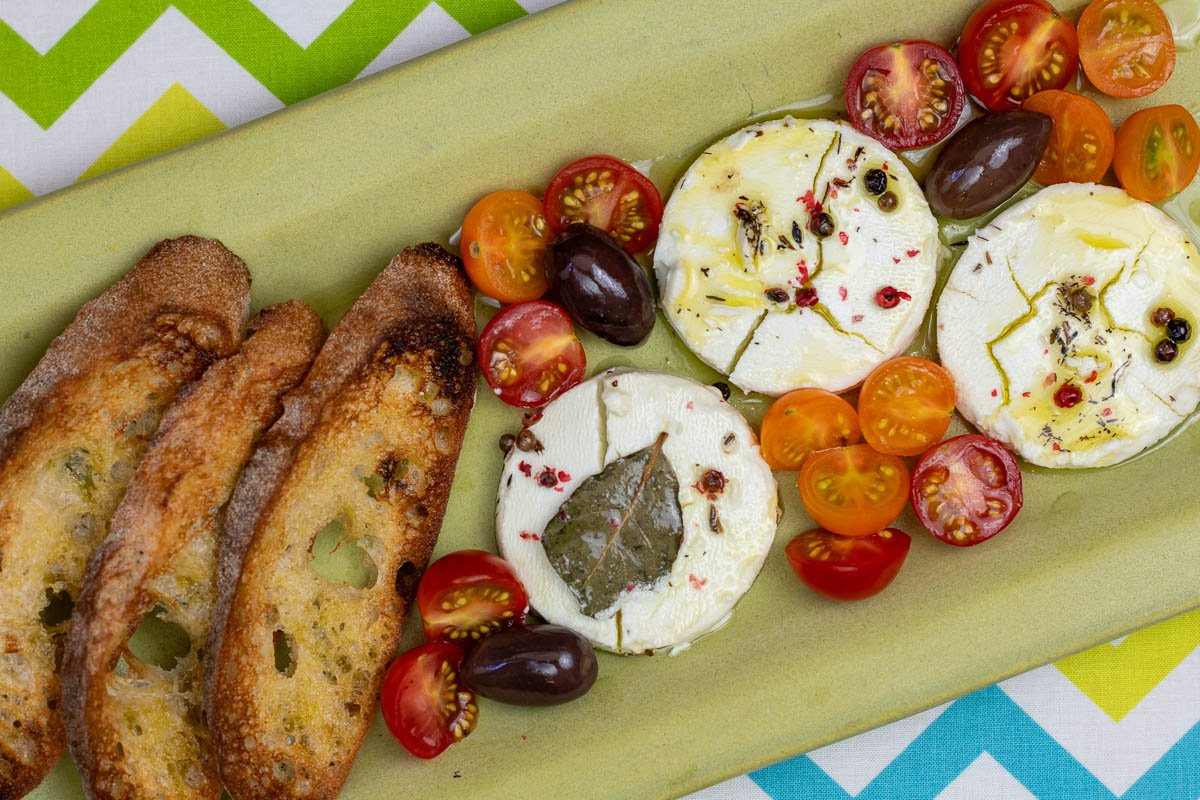Every year, I return from the American Cheese Society (ACS) conference with my brain spinning from all the conversations and ideas. I’m still trying to process everything I heard, observed and tasted at this packed three-day meeting, which a lot of attendees liken to summer camp. It’s certainly as fun as summer camp (if you’re a cheese nerd) but with less fresh air, more alcohol and way more food for thought. While I mentally unpack from the recent meeting in Des Moines, I wanted to share a few hot takes from the gathering, including a surprising statistic I heard about goat cheese.
Laura Chenel marinated goat cheeses
According to Christy Khattab, marketing director for Cypress Grove (makers of Humboldt Fog), roughly half of the goat cheese sold in this country is flavored, and flavored sales are now outpacing plain. I suppose that trend line shouldn’t surprise me given the dominance of flavored yogurt and flavored water. Sweet flavors outpoll savory, said Khattab, who spoke on a product innovation panel. That consumer insight drove Cypress Grove’s latest line extension: Meyer Lemon and Honey goat cheese. I’m on Team Savory myself and was glad to see Laura Chenel’s Marinated Thyme and Rosemary goat cheese (pictured above) land a blue ribbon at ACS.
On trend: Red Butte Hatch Chile Cheddar
Sweet flavors may be coming on strong, but Hatch chile is the flavor of the moment. It turned up everywhere at the conference, from Beehive’s Red Butte Hatch Chile to Cypress Grove Hatch Chile, Marieke Gouda Hatch Pepper and even a Beemster Gouda from Holland flavored with these roasted green capsicums. Marcel Vantuyn, who represents Beemster in the U.S., told me that demand for Hatch chiles far outstrips what New Mexico’s Hatch Valley can supply, so who knows what’s filling in the gap? Kind of like Italian olive oil that’s not from Italy.
Labor shortages continue to plague retailers. As a consumer, you can see evidence in the growing number of fixed-weight cheeses at understaffed cheese counters. These cheeses are pre-cut to a specific weight and sold at a package price instead of a per-pound price. The cutting is often done by a third party, not at the creamery or in store. Why should this matter? Because a cheese that’s cut to a random weight by the cheesemonger in the store is likely to be fresher. The monger probably tasted it and is more vested in selling it. And a random cut visually differentiates specialty cheese from a commodity product—a distinction not unimportant to the maker. Or to me. Some of the romance of cheese vanishes when it’s not cut by hand and every piece looks just the same.
Whole Foods continues to impress me with its investment in cheesemonger education. The chain sent 60-plus employees to the ACS conference this year to take the Certified Cheese Professional exam, and it provides many hours of test prep ahead of time. (I’ve led one of the training webinars for several years.) The company has encouraged and enabled employees to try for the CCP credential since the program launched in 2012 and is a major reason that more than 1,000 individuals nationwide now have CCP after their names.
Dutch Girl Creamery’s Charuth Van Beuzekom with husband Kevin Loth
As much as we cheese snobs love to celebrate small creameries with their hand-crafted cheeses, small is often not profitable. I sat in on an eye-opening panel about pasture-based farmstead cheese with owners of Missouri’s Green Dirt Farm, Prairie Fruits Farm in Illinois and Dutch Girl Creamery in Nebraska—all of whom won ACS ribbons. All three shared their sales, expenses and profit margins and it wasn’t pretty. Only Green Dirt Farm, still quite small but the largest of the three, appeared to be on stable footing—in large part because of revenue from a café. The other two acknowledged that they likely can’t survive without growing. They don’t lack demand. For most small producers, labor shortages and milk supply are the main barriers to growth.




